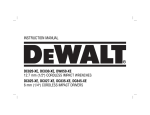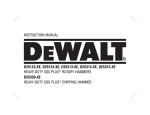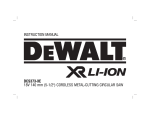Download DeWalt DW680 Instruction manual
Transcript
INSTRUCTION MANUAL DW680-XE HEAVY-DUTY 82 MM PLANER 1. WORK AREA a. Keep work area clean and well lit. Cluttered and dark areas invite accidents. b. Do not operate power tools in explosive atmospheres, such as in the presence of flammable liquids, gases or dust. Power tools create sparks which may ignite the dust or fumes. c. Keep children and bystanders away while operating a power tool. Distractions can cause you to lose control. 2. ELECTRICAL SAFETY a. Power tool plugs must match the outlet. Never modify the plug in any way. Do not use any adapter plugs with earthed (grounded) power tools. Unmodified plugs and matching outlets will reduce risk of electric shock. b. Avoid body contact with earthed or grounded surfaces such as pipes, radiators, ranges and refrigerators. There is an increased risk of electric shock if your body is earthed or grounded. c. Do not expose power tools to rain or wet conditions. Water entering a power tool will increase the risk of electric shock. d. Do not abuse the cord. Never use the cord for carrying, pulling or unplugging the power tool. Keep cord away from heat, oil, sharp edges or moving parts. Damaged or entangled cords increase the risk of electric shock. e. When operating a power tool outdoors, use an extension cord suitable for outdoor use. Use of a cord suitable for outdoor use reduces the risk of electric shock. 3. PERSONAL SAFETY a. Stay alert, watch what you are doing and use common sense when operating a power tool. Do not use a power tool while you are tired or under the influence of drugs, alcohol or medication. A moment of inattention while operating power tools may result in serious personal injury. b. Use safety equipment. Always wear eye protection. Safety equipment such as dust mask, non-skid safety shoes, hard hat, or hearing protection used for appropriate conditions will reduce personal injuries. Definitions: Safety Guidelines The definitions below describe the level of severity for each signal word. Please read the manual and pay attention to these symbols. DANGER: Indicates an imminently hazardous situation which, if not avoided, will result in death or serious injury. WARNING: Indicates a potentially hazardous situation which, if not avoided, could result in death or serious injury. CAUTION: Indicates a potentially hazardous situation which, if not avoided, may result in minor or moderate injury. NOTICE: indicates a practice not related to personal injury which, if not avoided, may result in property damage. IF YOU HAVE ANY QUESTIONS OR COMMENTS ABOUT THIS OR ANY DEWALT TOOL, CALL US AT: 1800 654 155 (Aust) or 0800 339258 (NZ). SAFETY INSTRUCTIONS FOR POWER TOOLS When using power tools, always observe the safety regulations applicable in your country to reduce the risk of fire, electric shock and personal injury. Read the following safety instructions before attempting to operate this product. Keep these instructions in a safe place. General Safety Rules WARNING! Read all instructions. Failure to follow all instructions listed below may result in electric shock, fire and/or serious injury. The term “power tool” in all of the warnings listed below refers to your mains operated (corded) power tool or battery operated (cordless) power tool. SAVE ALL WARNINGS AND INSTRUCTIONS FOR FUTURE REFERENCE 1 f. Keep cutting tools sharp and clean. Properly maintained cutting tools with sharp cutting edges are less likely to bind and are easier to control. g. Use the power tool, accessories and tool bits etc., in accordance with these instructions and in the manner intended for the particular type of power tool, taking into account the working conditions and the work to be performed. Use of the power tool for operations different from those intended could result in a hazardous situation. 5. SERVICE a. Have your power tool serviced by a qualified repair person using only identical replacement parts. This will ensure that the safety of the power tool is maintained. c. Avoid accidental starting. Ensure the switch is in the off position before plugging in. Carrying power tools with your finger on the switch or plugging in power tools that have the switch on invites accidents. d. Remove any adjusting key or wrench before turning the power tool on. A wrench or a key left attached to a rotating part of the power tool may result in personal injury. e. Do not overreach. Keep proper footing and balance at all times. This enables better control of the power tool in unexpected situations. f. Dress properly. Do not wear loose clothing or jewellery. Keep your hair, clothing and gloves away from moving parts. Loose clothes, jewellery or long hair can be caught in moving parts. g. If devices are provided for the connection of dust extraction and collection facilities, ensure these are connected and properly used. Use of these devices can reduce dust related hazards. 4. POWER TOOL USE AND CARE a. Do not force the power tool. Use the correct power tool for your application. The correct power tool will do the job better and safer at the rate for which it was designed. b. Do not use the power tool if the switch does not turn it on and off. Any power tool that cannot be controlled with the switch is dangerous and must be repaired. c. Disconnect the plug from the power source before making any adjustments, changing accessories, or storing power tools. Such preventive safety measures reduce the risk of starting the power tool accidentally. d. Store idle power tools out of the reach of children and do not allow persons unfamiliar with the power tool or these instructions to operate the power tool. Power tools are dangerous in the hands of untrained users. e. Maintain power tools. Check for misalignment or binding of moving parts, breakage of parts and any other condition that may affect the power tools operation. If damaged, have the power tool repaired before use. Many accidents are caused by poorly maintained power tools. Electrical Safety The electric motor has been designed for one voltage only. Always check that the power supply corresponds to the voltage on the rating plate. 230 V AC means your tool will operate on alternating current. As little as 10% lower voltage can cause loss of power and can result in overheating. All DEWALT tools are factory tested; if this tool does not operate, check the power supply. Your DEWALT tool is double insulated, therefore no earth wire is required. • Young children and the infirm. This appliance is not intended for use by young children or infirm persons without supervision. Young children should be supervised to ensure that they do not play with this appliance. • Replacement of the supply cord. If the supply cord is damaged, it must be replaced by the manufacturer or an authorised DEWALT Service Centre in order to avoid a hazard. Extension Cords CAUTION: Use only extension cords that are approved by the country’s Electrical Authority. Before using extension cords, inspect them for loose or exposed wires, damaged insulation and defective fittings. Replace the cord if necessary. 2 MINIMUM GAUGE FOR CORD SETS For Cable length (m): 7.5 15 25 30 Use Cable with minimum rating (Amperes) Tool Amperes 0 - 3.4 7.5 7.5 7.5 7.5 7.5 3.5 - 5.0 7.5 7.5 7.5 7.5 10 5.1 - 7.0 10 10 10 10 15 7.1 - 12.0 15 15 15 15 20 12.1 - 20.0 20 20 20 20 25 45 • Be sure that the blades are mounted as described in the instruction manual and check that all screws are firmly tightened before connecting unit to power source. • Keep air vents unobstructed for proper motor cooling. • DO NOT lay tool down on shoe when the blades are exposed. This can chip the blades. • Keep side discharge chute unobstructed at all times. • Never reach under the tool for any reason unless it is turned off and UNPLUGGED. BLADES ARE EXPOSED AND EXTREMELY SHARP. • Use this tool for working with wood and wood products only. • Never operate without securely holding the front handle. • Always operate planer with two hands. • Planer blades are extremely sharp. Handle with great care. • Clean out your tool often, especially after heavy use. 60 7.5 15 15 20 – ADDITIONAL SAFETY INSTRUCTIONS FOR PLANERS • To reduce the risk of injury, user must read and understand instruction manual before operating planer. • Always wear eye protection and dust mask. • Be sure the voltage agrees with specific data on the nameplate. • Make certain that the switch is in the off position before connecting plug to a power source. • Be sure to switch OFF immediately if tool is jammed in work. • Be sure tool is set for correct depth before turning switch to ON. • Be sure to use specified replacement parts only. • Be sure tool is disconnected from power source when cleaning or making adjustments to the tool. • Be sure to maintain tool with care. Follow instructions for lubricating and changing accessories. • Stay alert – never operate the unit when tired or under the influence of drugs, alcohol, or medication. • Be sure to store tool in a clean dry place after disconnecting from power source. • Do not use in dangerous environments. Do not use near flammable substances, in damp or wet locations, or expose to rain. WARNING: ALWAYS wear approved protective safety equipment complying with the following standards: • Eye protection: AS/NZS1337 Eye Protectors for Industrial Applications; • Hearing protection: AS/NZS1270 Acoustics – Hearing Protection; • Respiratory protection: AS/NZS1716 Respiratory Protective Devices. WARNING: Some dust created by power sanding, sawing, grinding, drilling, and other construction activities contains chemicals known to cause cancer, birth defects or other reproductive harm. Some examples of these chemicals are: • lead from lead-based paints, • crystalline silica from bricks and cement and other masonry products, and • arsenic and chromium from chemically-treated lumber (CCA). Your risk from these exposures varies, depending on how often you do this type of work. To reduce your exposure to these chemicals: work in a well ventilated area, and work with approved safety equipment, such as those dust masks that are specially designed to filter out microscopic particles. • Avoid prolonged contact with dust from power sanding, sawing, grinding, drilling, and other construction activities. Wear protective clothing and wash exposed areas with soap and water. Allowing dust to get into your mouth, eyes, or lay on the skin may promote absorption of harmful chemicals. 3 Components (Fig. 1) WARNING: Use of this tool can generate and/or disburse dust, which may cause serious and permanent respiratory or other injury. Always use AS/NZS standard approved respiratory protection appropriate for the dust exposure. Direct particles away from face and body. WARNING: We recommend the use of a residual current device with a residual current rating of 30mA or less. CAUTION: Wear appropriate personal hearing protection during use. Under some conditions and duration of use, noise from this product may contribute to hearing loss. • The label on your tool may include the following symbols. The symbols and their definitions are as follows: V ..................volts A ..............amperes Hz ................hertz W .............watts min ..............minutes ..........alternating current .........direct current ..........alternating or direct current no .............no load speed ...............Class I Construction ....................(grounded) ............earthing terminal ...............Class II Construction ............safety alert symbol ....................(double insulated) BPM .........beats per minute …/min .........per minute RPM .........revolutions per minute sfpm ............surface feet per minute A. Trigger switch B. Lock-on button C. Depth adjustment knob/front handle D. Switch Handle FIG. 1 B E. F. G. H. Shoe Rabbet fence (not shown) Rabbet fence adjustment knob Chip discharge chute D A C G H G E OPERATION WARNING: To reduce the risk of serious personal injury, turn tool off and disconnect tool from power source before making any adjustments or removing/ installing attachments or accessories. Motor SAVE ALL WARNINGS AND INSTRUCTIONS FOR FUTURE REFERENCE Be sure your power supply agrees with the nameplate markings. 230 volts AC means your tool may be operated only with alternating current and never with direct current. Voltage decrease of more than 10% will cause loss of power and overheating. All DEWALT tools are factory tested; if this tool does not operate, check the power supply. Introduction Switch (Fig. 1) Examine Figure 1 and your planer for a few minutes to become familiar with the various features and the names used to describe them. The following sections will discuss the various controls and you will need to know where they are. CAUTION: Check that the tool is not ON before connecting it to a power supply. If the trigger switch is ON when the tool is connected to the power supply, it will start immediately. Damage to your tool or personal injury may result. 4 FIG. 2 CAUTION: Allow the tool to reach full speed before touching tool to the work surface. Lift the tool from the work surface before turning the tool off. To start the planer depress the trigger switch (A). To turn the planer off, release the trigger switch. D Adjusting Planing Depth (Fig. 1) WARNING: To reduce the risk of serious personal injury, turn tool off and disconnect tool from power source before making any adjustments or removing/ installing attachments or accessories. Planing depth is infinitely variable from 0 to 2.5 mm. To adjust the cutting depth, rotate the depth adjustment knob/front handle (C) clockwise from the “0” position. Each click of the adjustment knob represents approximately 0.1 mm of depth. The cutting depth will increase from 0 to as much as 2.5 mm. It is recommended that test cuts be made in scrap wood after each re-adjustment to make sure that the desired amount of wood is being removed by the planer. Several shallow passes (rather than one deep one) will produce a smoother finish. C E CORRECT FIG. 3 FIG. 4 Planing (Fig. 2, 3, 4) CAUTION: Allow the tool to reach full speed before touching tool to the work surface. Lift the tool from the work surface before turning the tool off. Hold the planer in the correct position with one hand on the front handle (C) and the other hand on the switch handle (D) as shown in Figure 2. Place the front of the shoe (E) on the surface to be planed, making certain that the cutting blades are not touching the surface. Push down firmly on the front handle of the planer so that the front shoe is ABSOLUTELY FLAT on the work surface. Squeeze the trigger switch and allow the motor to reach full speed before touching the planer blades to the work surface. Move the tool slowly into the work and maintain downward pressure to keep the planer flat. Be particularly careful to keep the tool flat at the beginning and the end of the work surface (Figures 2, 3, 4). Planing Tip: For a smoother appearance, fasten a piece of scrap wood to the end of the piece you are planing. Don’t stop planing until the cutting blades of the planer are past your workpiece and into the scrap material. INCORRECT INCORRECT Rabbet Fence (Fig. 5, 6) WARNING: To reduce the risk of serious personal injury, turn tool off and disconnect tool from power source before making any adjustments or removing/installing attachments or accessories. CAUTION: Allow the tool to reach full speed before touching tool to the work surface. Lift the tool from the work surface before turning the tool off. The rabbet fence can be installed on either side of your planer. The planer can make rabbet cuts up to 12 mm. 5 To Install Rabbet Fence Reversible Carbide Blades 1. Loosen the rabbet fence adjustment knob (G). 2. Slide the crossbar on the rabbet fence (F) into the hole near the front of the planer as shown in Figure 5. 3. Securely tighten rabbet fence adjustment knob (G) as shown in Figure 6. 4. The rabbet fence should be below the planer when installed correctly as shown in Figure 5. 1. To Remove Blade from Planer a. Loosen and remove the three hex head screws (J) with the 5 mm hex wrench provided. Remove the drum cover (K) from the drum (Q). b. Remove the blade carrier/guide bar assembly. Carefully remove the carbide blade (I). FIG. 7 FIG. 6 FIG. 5 FIG. 8 Q M K I Q J L L P P G J I F To Make a Rabbet Cut FIG. 9 1. To adjust the width of cut loosen rabbet fence knob (G), move fence to the desired position then securely tighten rabbet fence knob. 2. Make several cuts until the desired depth is reached. NOTE: It will be necessary to make quite a few cuts for most rabbet applications. P M FIG. 10 L P M I R O N N To Change Blades (Fig. 7, 8, 9, 10) K M O WARNING: To reduce the risk of serious personal injury, turn tool off and disconnect tool from power source before making any adjustments or removing/ installing attachments or accessories. NOTE: The DW680-XE has two blades, one on each side of the blade drum, as shown in Figure 7. Any operation or adjustment should be made to both blades. 2. To Adjust Blade Using Gauge Plate (provided with tool) a. Cautiously place the carbide blade on the gauge plate (N) with the grooved side of the carbide blade facing up. Either edge of the reversible carbide blade can be set flush against the gauge plate inside wall (O). b. Place the blade carrier/guide bar assembly on the blade so that the rib on the blade carrier (L) fits into the groove on the carbide blade (I). The heel of the blade carrier (M) will overlap the end of the gauge plate (N). c. Loosen the two hex screws (P) with the 2.5 mm hex wrench provided. 6 3. To Reinstall Blade a. Cautiously remove the adjusted guide bar/high speed steel blade assembly from the gauge plate (N) and place the heel of the guide bar (M) into the groove in the drum (Q). b. Set the drum cover (K) over the adjusted guide bar/high speed steel blade assembly and securely tighten the three hex screws (J) to the drum. 4. Repeat procedure for the other blade. d. Simultaneously push the blade carrier (L) and the guide bar (M) into the gauge plate inside wall (O), making sure that the carbide blade (I) is held firmly against the gauge plate inside wall (O) and securely tighten the two hex screws (P). 3. To Reinstall Blade a. Remove the adjusted blade carrier/guide bar assembly from the gauge plate (N) and place the heel of the guide bar (M) into the groove on the drum (Q). b. Place the drum cover (K) over the blade carrier/guide bar assembly. Loosely screw the three hex screws (J) into the drum (Q) so that there is a small gap between the drum and the blade carrier (L). c. Slide the carbide blade between the drum (Q) and the blade carrier (L) so that the rib on the blade carrier sets into the groove in the blade. d. Center the carbide blade (I) under the blade carrier (L) making sure the blade is clear of the tool housing on both sides. e. Securely tighten the three hex screws (J) to the drum. 4. Repeat procedure for the other blade. Parking Foot (Fig. 11) Your planer is equipped with a parking foot (S) FIG. 11 that automatically lowers into place when the tool is lifted from the work surface. When planing, the parking foot raises as the tool is pushed forward. When the parking foot is lowered, the planer can set on the work surface without the blade touching. Edge Chamfering (Fig. 12) High-speed Steel Blades FIG. 12 Your planer has three precision machined chamfering grooves (T) in the front shoe for planing along a corner of the wood (Fig. 12). The width of the grooves are 1.5 mm, 2 mm, and 2.5 mm. It’s a good idea to try a piece of scrap wood before doing finish work. 1. To Remove Blade from Planer a. Loosen and remove the three hex head screws (J) with the 5 mm hex wrench provided. Remove the drum cover (K) from the drum (Q). b. Cautiously remove the guide bar/high speed steel blade assembly. 2. To Adjust Blade Using Gauge Plate (provided with tool) a. Place the guide bar/high speed steel blade assembly on the gauge plate (N) with the cutting edge of the high speed steel blade flush against the gauge plate inside wall (O). The heel of the guide bar (M) will overlap the end of the gauge plate (N). b. Loosen the two hex screws (P) with the 2.5 mm hex wrench provided. c. Simultaneously push the high speed steel blade (R) and the guide bar (M) into the gauge plate inside wall (O), making sure that the blade is held firmly against the gauge plate inside wall (O) and securely tighten hex screws (P). MAINTENANCE T WARNING: To reduce the risk of injury, turn unit off and disconnect tool from power source before installing and removing accessories, before adjusting or changing set-ups or when making repairs. Be sure the trigger switch is in the OFF position. An accidental start-up can cause injury. 7 S Cleaning (Fig. 13) Guarantee FIG. 13 Applicable to hand held Power Tools, Lasers and Nailers. WARNING: Clean the chip discharge chute (H) regularly. ALWAYS WEAR SAFETY GLASSES. CAUTION: Never use solvents or other harsh chemicals for cleaning the non-metallic parts of the tool. H Use only mild soap and damp cloth to clean the tool. Never let any liquid get inside the tool; never immerse any part of the tool into a liquid. Three Year Limited Warranty DEWALT will repair, without charge, any defects due to faulty materials or workmanship for three years from the date of purchase. Please return the complete unit, transportation prepaid, to any DEWALT Service Centre, or any authorised service station. For warranty repair information, call (AUS) 1800 654 155 or (NZ) 0800 339258. This warranty does not apply to • Accessories • Damage caused where repairs have been made or attempted by others. • Damage due to misuse, neglect, wear and tear, alteration or modification. This warranty gives you specific legal rights and you may have other rights under the provisions of the Consumer Guarantee Act 1993 (New Zealand only), Trade Practices Act 1974 and State Legislation (Australia only). In addition to the warranty, DEWALT tools are covered by our: FREE ONE YEAR SERVICE CONTRACT DEWALT will also maintain the tool for free at any time during the first year of purchase. This includes labour, parts and lubrication required to restore the product to sound mechanical and/or electrical condition. Normal wear parts are not covered in this service. Carbon brushes worn more then 50% will be replaced. NOTE: Three Year Warranty is not applicable to items deemed as consumables. Radial arm saws are covered by a one (1) year warranty only. DEWALT Reserves the right to review its warranty policy prior to launch of any new business development products. 30 DAY NO SATISFACTION GUARANTEE If you are dissatisfied with any DEWALT power tool, laser or nailer, for any reason, simply return it to the point of purchase with your sales receipt within 30 days for a replacement unit or a full refund. Lubrication DEWALT tools are properly lubricated at the factory and are ready for use. Repairs To assure product SAFETY and RELIABILITY, repairs, maintenance and adjustment (including brush inspection and replacement) should be performed by certified service centers or other qualified service organizations, always using identical replacement parts. ACCESSORIES WARNING: Since accessories, other than those offered by DEWALT, have not been tested with this product, use of such accessories with this tool could be hazardous. To reduce the risk of injury, only DEWALT, recommended accessories should be used with this product. Recommended accessories for use with your tool are available at extra cost from your local service center. If you need any assistance in locating any accessory, please contact DEWALT Industrial Tool Co., 20 Fletcher Road, Mooroolbark, VIC 3138 Australia or call 1800 654 155 or (NZ) 0800 339258. 8 FREE WARNING LABEL REPLACEMENT: If your warning labels become illegible or are missing, call (AUS) 1800 654 155 or (NZ) 0800 339258 for a free replacement. 9 DEWALT Industrial Tool Co., 701 East Joppa Road, Baltimore, MD 21286 • 20 Fletcher Road, Mooroolbark, VIC 3138 Australia (AUG10) Part No. N090451 DW680-XE Copyright © 2010 DEWALT The following are trademarks for one or more DEWALT power tools: the yellow and black color scheme; the “D” shaped air intake grill; the array of pyramids on the handgrip; the kit box configuration; and the array of lozenge-shaped humps on the surface of the tool.




















